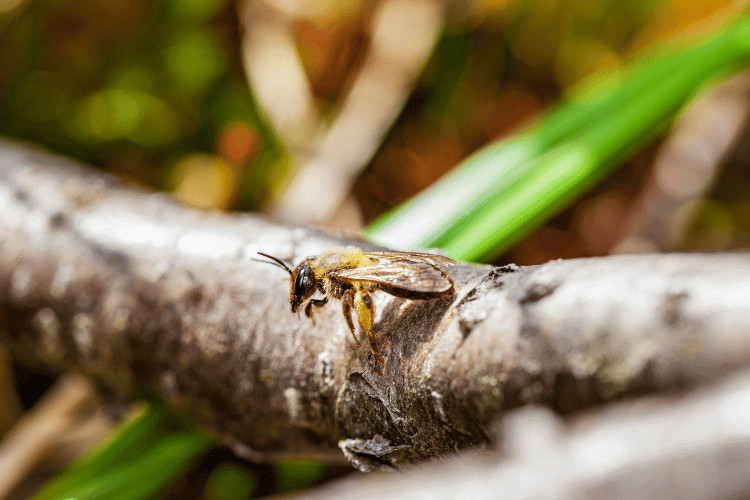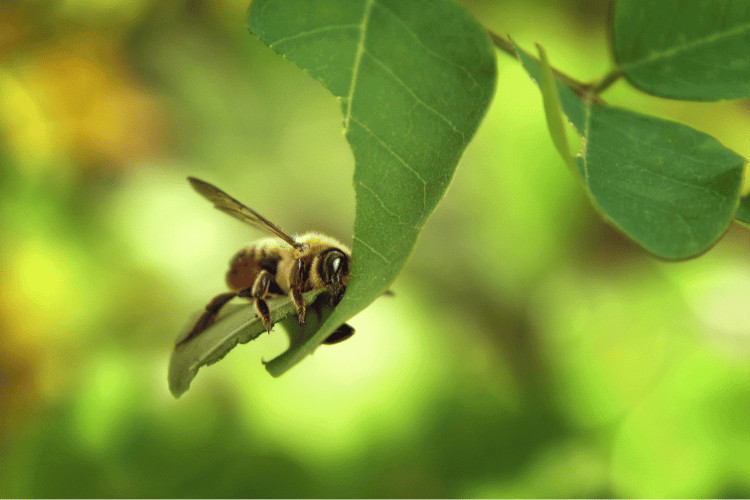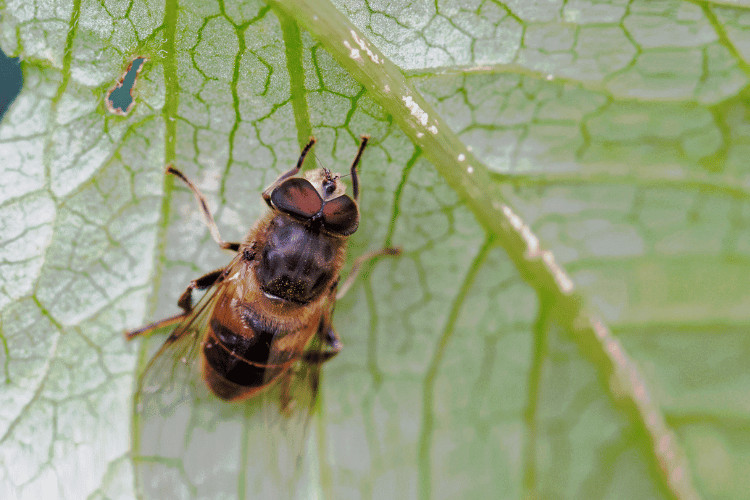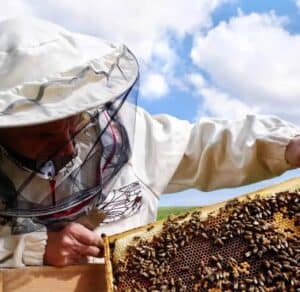Leafcutter Bees: The Architects of the Wild
I once had a leafcutter bee nest in my garden. I was amazed to see the female bee cutting leaves of plants and carrying them back to her nest, as she was so industrious, and dedicated to her task. I was also grateful for her pollination services, as my garden thrived that year.
Leafcutter bees are solitary bees that get their name from their habit of cutting leaves to build their nests. These bees are important pollinators, and they can help to increase the yields of fruits, vegetables, and flowers.
If you want to know more about these master weavers, read on!
Description and Characteristics of Leafcutter Bees

Leafcutter bees, or Megachilidae, is a large family of bees that includes over 15,000 species. Leafcutter bees are found in all parts of the world, except for Antarctica. They’re medium-sized bees, about the size of a honeybee.
These bees are black with yellow or orange markings, and they have stout bodies and large heads. The females have a mild sting, but the males don’t have a stinger at all.
The most distinctive feature of leafcutter bees is their mandibles. These jaws are very strong, and they’re used to cut leaves. Leafcutter bees use the leaves to build their nests, which are made up of small cells. Each cell contains an egg and a ball of pollen and nectar.
What Is a Leafcutter Bee’s Purpose?
Leafcutter bees are solitary bees that are important pollinators of a variety of plants, including fruits, vegetables, and flowers. They’re especially important for pollinating crops that aren’t easily pollinated by honeybees, such as blueberries and tomatoes.
Here are some of the benefits of leafcutter bees:
- They’re efficient pollinators. They’re able to visit more flowers in a day than honeybees, and they’re also more effective at transferring pollen.
- They’re cold-hardy. They can survive in cold winters, which makes them valuable pollinators in colder climates.
- They’re not aggressive. They’re less likely to sting than honeybees, making them a safe option for people who are allergic to bees.
- They can be useful for beekeepers. They can be used to pollinate crops that aren’t easily pollinated by honeybees, and they can also be used to supplement the pollination services of honeybees.
Leafcutter Bees Habitat and Foraging Preferences
Leafcutter bees are found in a variety of locations. Their habitat preferences depend on the species of leafcutter bee. Some species prefer open, sunny areas, while others prefer shady areas. Some species prefer sandy soil, while others prefer clay soil.
Leafcutter bees are solitary bees, which means that they do not live in colonies like honeybees. They’re also generalist pollinators, which means that they pollinate a variety of plants. Some of the plants that they pollinate include blueberries, tomatoes, roses, and clover.
Here are some of the factors that influence the foraging preferences of leafcutter bees:
- The availability of food sources. Leafcutter bees need pollen and nectar to survive, so they will forage in areas where these resources are abundant.
- The presence of nesting sites. Leafcutter bees need a place to build their nests, so they will forage in areas where there are suitable nesting sites.
- The weather conditions. Leafcutter bees are active during the day, so they will forage in areas where the weather is warm and sunny.
- The presence of predators. Leafcutter bees are preyed upon by a variety of animals, so they will avoid foraging in areas where there are a lot of predators.
Where Can You Find Leafcutter Bees?
Leafcutter bees are found in a variety of habitats, including gardens, meadows, and forests. They are most common in temperate regions, but they can also be found in tropical regions.
Here are some of the places where you might find leafcutter bees:
- In gardens, near flowers that bloom throughout the season.
- In meadows, near wildflowers.
- In forests, near trees and shrubs.
- In parks and other natural areas.
- In backyards, near birdbaths, and other water sources.
- In compost piles, where they can find pollen and nectar.
- In abandoned buildings, where they can find nesting sites.
Leafcutter Bees Life Cycle, Mating, and Nesting
The life cycle of leafcutter bees is similar to that of other solitary bees. As for the mating of leafcutter bees; well, it’s a complex process!
The males emerge first and patrol the area around the nests, looking for females. When a male finds a female, he will court her by dancing and vibrating his wings. If the female is receptive, she will allow the male to mate with her.
The nesting habits of leafcutter bees vary depending on the species. Some species nest in pre-existing cavities, such as holes in wood or hollow stems. Other species dig their own nests in the soil. The nests are usually lined with leaves that the female has cut.

Here are some additional details about the life cycle, mating, and nesting habits of leafcutter bees:
Life Cycle
- The female leafcutter bee overwinters as a mature larva.
- She emerges in the spring to build her nest.
- The nest is usually made in a cavity inside wood or in the soil.
- The female lays an egg in each cell of the nest.
- The egg hatches into a larva.
- The larva feeds on the pollen and nectar that the female has provisioned.
- The larva pupates.
- The adult bee emerges in the spring.
Mating
- The males emerge first and patrol the area around the nests, looking for females.
- When a male finds a female, he will court her by dancing and vibrating his wings.
- If the female is receptive, she will allow the male to mate with her.
Nesting Habits
- Some species nest in pre-existing cavities, such as holes in wood or hollow stems.
- Other species dig their own nests in the soil.
- The nests are usually lined with leaves that the female has cut.
- Each cell in the nest contains an egg and a ball of pollen and nectar.
Importance of Leafcutter Bees in Ecosystems and Agriculture
Leafcutter bees are important pollinators in both ecosystems and agriculture. They’re especially important for pollinating crops that are not easily pollinated by honeybees, such as blueberries and tomatoes.
These busy buddies are even more efficient pollinators than honeybees, and they can pollinate a wider variety of crops. Leafcutter bees are also less likely to spread diseases, which can be a problem with honeybees.
In ecosystems, leafcutter bees help to ensure the pollination of wildflowers and other plants. This is important for the food chain, as many animals rely on these plants for food. Leafcutter bees also help to disperse seeds, which helps to maintain the diversity of plant life.
In agriculture, leafcutter bees can help to increase crop yields. For example, a study found that leafcutter bees increased blueberry yields by 25%. This is because leafcutter bees are more efficient pollinators than honeybees and they can work in cooler temperatures.
Common Questions About Leafcutter Bees
What Do Leafcutter Bees Eat?
Like many other bees, leafcutter bees eat pollen and nectar from flowers. They collect pollen on the undersides of their abdomens, and they store nectar in their honey stomachs.
The pollen and nectar provide the bees with the energy they need to fly, build their nests, and care for their young.
Leafcutter bees also need water. They get water from flowers, puddles, and other sources. Water is important for the bees to stay hydrated and to help them cool down.
Are Leafcutter Bees Dangerous?
Leafcutter bees are not considered to be dangerous. They’re solitary bees, which means that they don’t live in colonies like honeybees. This makes them less likely to be aggressive.
The females of some species of leafcutter bees have a sting, but it isn’t as painful as the sting of a honeybee. The males of all species of leafcutter bees don’t have a sting.
Leafcutter bees are attracted to flowers, and they may sometimes land on people. However, they aren’t likely to sting unless they feel threatened.
What Size Are Leafcutter Bees?
Leafcutter bees are about the size of a honeybee, ranging in size from 0.25 to 0.5 inches (5 to 12 millimeters).
The smallest species of leafcutter bee is the Megachile centuncularis, which is only about 0.25 inches (5 millimeters) long. The largest species of leafcutter bee is the Megachile lachrymosa, which can grow up to 0.5 inches (12 millimeters) long.
How to Identify Leafcutter Bees?
Here are some of the key features that can help you identify leafcutter bees:

- Size: Leafcutter bees are about the size of a honeybee, ranging in size from 0.25 to 0.5 inches (5 to 12 millimeters).
- Color: Leafcutter bees are black with yellow or orange markings. The markings can vary depending on the species, but they’re often found on the abdomen.
- Body shape: Leafcutter bees have particularly large heads. They also have pronounced jaws that they use to cut leaves.
- Wings: Leafcutter bees have long, narrow wings. The wings are often clear, but they can also have some yellow or orange markings.
- Behavior: Leafcutters don’t live in colonies like honeybees. They’re often seen hopping from flower to flower, and they may sometimes fly around people.
How to Attract Leafcutter Bees?
Here are some tips on how to attract leafcutter bees to your garden:
- Plant a variety of flowers that bloom throughout the season. Some good choices include coneflowers, clover, goldenrod, lavender, and sunflowers.
- Provide nesting sites. Leafcutter bees need a place to build their nests, so you can provide them with nesting sites by placing bamboo tubes or hollow logs in your garden. You can also buy commercial nesting blocks for leafcutter bees.
- Avoid using pesticides. Pesticides can kill leafcutter bees, so it is important to avoid using them in your garden. If you must use pesticides, choose those that are labeled as being safe for bees.
- Make your garden welcoming to bees. Leafcutter bees are attracted to gardens that are shady and have plenty of flowers. You can also provide them with a water source, such as a birdbath or a shallow dish of water.
Conclusion
As a beekeeper, I have a deep appreciation for leafcutter bees. They’re fascinating insects that play an important role in the ecosystem. I have seen firsthand how they can help to pollinate crops and flowers, and I’m grateful for their contribution.
One of my favorite stories about leafcutter bees is when I was first starting out as a beekeeper. I was having trouble getting my honeybees to pollinate my blueberry bushes. So, I decided to try attracting leafcutter bees, and I was amazed at how effective they were.
The blueberries were loaded with fruit, and I was so happy that I had found a way to help these important pollinators.
Unfortunately, leafcutter bees are declining in numbers due to habitat loss and the use of pesticides. By working together, we can ensure the survival of leafcutter bees and the pollination of our plants.

Joseph Davis
My goal is to show that anyone can take up beekeeping and it can be a very rewarding hobby. I strive to share my experiences and answer any questions you may have.
